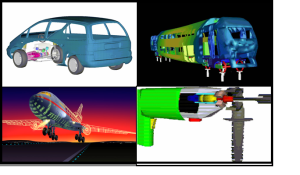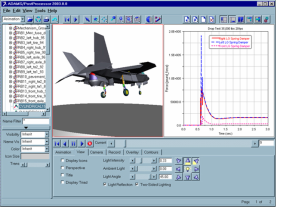 There is no more significant producer of the automobiles, aircrafts, ships, rail vehicles, weapons, mechatronical devices, consumable electronics, devices for lunaparks, in a word of all the moving things in the world, which wouldn't have in the equipment program MSC.ADAMS.
There is no more significant producer of the automobiles, aircrafts, ships, rail vehicles, weapons, mechatronical devices, consumable electronics, devices for lunaparks, in a word of all the moving things in the world, which wouldn't have in the equipment program MSC.ADAMS.
Program MSC.ADAMS (Automatic Dynamic Analysis of Mechanical Systems) has been developed by the company MDI (Mechanical Dynamics, Inc., USA) for 25 years and since 2002 has belonged in portfolio of products of the company MSC.Software, Inc., USA, (Mac Neal Schwendler).
Program MSC.ADAMS as the leading representant of the MSS technology of the simulation of mechanical systems has the interactive environment for automatized dynamic analysis of the parametrized mechanical systems. Structure of the mechanical system can be arbitrary and can include rigid or flexible bodies with geometric, kinematic or force constraints. Forces acting on the mechanical system can be gravitational, inertial, experimentaly determined contact forces, frictional, aerodynamic, hydrodynamic or electromagnetic. Mechanical systems can include control, hydraulic or pneumatic circuits as well.
Program MSC.ADAMS enables to model, analyse and optimize virtual prototypes of the future products and investigate their properties before realization of the real prototype. At present, program covers more than 50% of the world market in it's field. MSC.ADAMS is suitable tool for development of the miniature mechatronic elements and also for investigation of complex structures as automobiles, aircrafts and even human body.
 Program MSC.ADAMS fulfil it's integrative mission in all the phases of the engineering activities at development, tests, manufacturing, assembling and operation of products by kinematic analysis of the functionality, dynamic analysis of the load behaviour of the structural elements, modal analysis of the modal shapes and responses to excitation in time and frequency domain. The cosimulation of the mechanical and the control systems is possible as well. Thus the program MSC.ADAMS enable to reach the effect of the synergy of the strength of the individual technologies and reduction of the occurrence of the construct imperfections already in beginning phase of development of the product.
Program MSC.ADAMS fulfil it's integrative mission in all the phases of the engineering activities at development, tests, manufacturing, assembling and operation of products by kinematic analysis of the functionality, dynamic analysis of the load behaviour of the structural elements, modal analysis of the modal shapes and responses to excitation in time and frequency domain. The cosimulation of the mechanical and the control systems is possible as well. Thus the program MSC.ADAMS enable to reach the effect of the synergy of the strength of the individual technologies and reduction of the occurrence of the construct imperfections already in beginning phase of development of the product.
It has been shown, that permanently increasing demands of the quality of the products can bee fullfiled only by multidisciplined access with virtual prototyp which has all deciding properties and is computationaly stable.
These demands fulfill high-end program MSC.ADAMS with flexible Motif/Windows user interface in wich is posible to model object with Parasolid CAD geometry, analyse and visualize results for virtual prototype with various degree of complexity and share them with partners via Netscape Navigator.
Quality of the program MSC.ADAMS is determined by solver, that is why pioneers as Orlandea, Chace, Calahan, Gear, Wielenga decidet to put main accent on intensive research of the numerical solutions of the systems of DAE (Differencial-Algebraic Equations - mixed system of the nonlinear constraint algebraic equations and differential equations of motion). The result of their effort are revolutionary changes in algorithmization of the new substitution methods of the decreasing of the order of the differencial equations and methods of the spare matrices for stable work of numeriacal intergrators. These numerical integrators works as explicit predictor-corrector with variable step and backward differenciating, or according the method of the sorted coordinates.
 According to Hurty's proposal Craig and Bampton developed technique of the modal synthesis. This technique is important for getting computionally undemanding flexible body for dynamic analyses from MNF file (Modal Neutral File) imported from the FEA envronment.
By help of the modal coordinates, tensor of strain and stress and by using of technique MSR (Modal Stress Recovery) we can animate strain and stress directly in MSC.ADAMS environment. The contribution is determination of the time history of dynamic loads as well. These dynamic loads are inputs for strength and fatique analysis in FEA environment.
According to Hurty's proposal Craig and Bampton developed technique of the modal synthesis. This technique is important for getting computionally undemanding flexible body for dynamic analyses from MNF file (Modal Neutral File) imported from the FEA envronment.
By help of the modal coordinates, tensor of strain and stress and by using of technique MSR (Modal Stress Recovery) we can animate strain and stress directly in MSC.ADAMS environment. The contribution is determination of the time history of dynamic loads as well. These dynamic loads are inputs for strength and fatique analysis in FEA environment.
Users of the program MSC.ADAMS are getting in their hands multidisciplinary tool with built-in algoritms of procedures from the fields of numerical mathematics, statistics, theory of mechanics of continuum, theory of probability, optimization methods and theory of control. Users can now use in their work the latest methods, which has been the domain of the narrow group of scientist a short time ago.
Multi-level communication with program suits beginners (icons, working environment according the demands), advanced users (commands, command files, macros) and the professionals (subroutines, customization of the working environment) as well.
User has in addition of on-line documentation to disposition plenty of tools as:
 MSC.ADAMS has algorithmized, statistical and probabilistic methods for realization of the pointed virtual experiments DOE (Design of Experiment), analisis of the sensibility (Screening) by method DS (Design Study) and applications of the method RSM (Response Surface Method). ADAMS/Chassis in collaboration with ADAMS/Insight allows investigate rate of influences of the individual factors on preperties of the vehicle by RMS method and Pareto behaviour.
MSC.ADAMS has algorithmized, statistical and probabilistic methods for realization of the pointed virtual experiments DOE (Design of Experiment), analisis of the sensibility (Screening) by method DS (Design Study) and applications of the method RSM (Response Surface Method). ADAMS/Chassis in collaboration with ADAMS/Insight allows investigate rate of influences of the individual factors on preperties of the vehicle by RMS method and Pareto behaviour.
Program MSC.ADAMS has developed working environment to sharing of the datas with technologies:
program MSC.ADAMS as multidisciplinary expert system:
Other informations you can find at web page of the producer or from promotional materials to modules MSC.ADAMS/View or MSC.ADAMS/Car.
In this representative is an example of application of inverse kinematic analysis within program MSC.ADAMS for determination of such course of slew of individual parts of robotic system IRB 1600 from company ABB in order to achieve desirable course of end part (the torch) during technological operation of welding. You can compare real working cycle from video with simulation from environment of program MSC.ADAMS.


